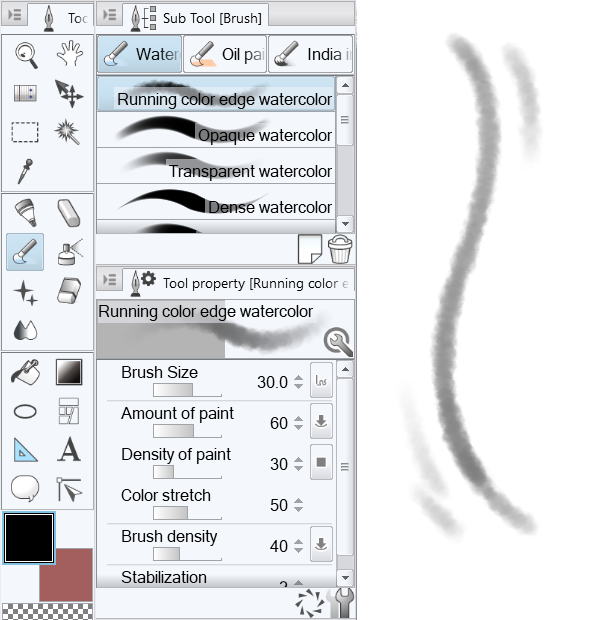
Here's what the finished color-blocking looks like. Once I have a rough color palette blocked in, I'll use the Hue/Saturation settings to tweak the colors until they're perfect. In Photoshop go to Image > Adjustments > Hue/Saturation or in Procreate go to Adjustments > Hue, Saturation, Brightness). Insight: I often find inspiration observing the color palettes used by other artists in different areas such as animation, movies, music videos etc. Repeat this step for every color, making sure each color is on its own layer. In Procreate you can do this using the Reference Layer feature and ColorDrop. Once you have your selection use the paint bucket tool to fill it with color. Select & fillĬreate a new layer then use the lasso or magic wand tool to select each area you want to color in. The choice for the background color is the key for a good illustration as it gives the tone of the composition. These brushes are great for creating halftone shading as they get darker as you press harder on the screen with your pen.įor this illustration, I chose 5 colors and one extra color for the background. I'm using the Beat Tones Shader rush (Dot 2 - 45º / Med). This helps create depth and a sense of perspective in the illustration. Once you have finished making corrections it's time to start working with textures to give some form to the main elements of the illustration (in this case, the cat and the skull). Insight: I like to leave some pencil marks on my scan to retain some of the analog aesthetic, but you can erase these and make any other touchups before adjusting your levels.Īdding depth with the Beat Tones Halftone Brushes. If you're using Procraete, you can make a similar adjustment using the Curves setting. You want the black linework to be dark and consistent, and the whites to be nice and bright. Go to Image > Adjustments > Levels and adjust the shadow, mid-tone, and highlight sliders as shown below. Use Photoshop's Levels settings to adjust the contrast of your linework. As you can see, the blacks are pretty washed out so we'll fix that in the next step. Scan the illustration at 600 dpi in grayscale mode then open it in Photoshop. You can see my process in the video below.įinish the illustration using a white gel pen to make highlights and little details like stars. Sounds simple right? Jokes aside, drawing and inking takes time and practice, so keep at it and enjoy the journey. Use your pens to ink in the pencil sketch and add in all the missing details. I always lay an extra sheet of paper under my wrist to avoid any smudges made by the wet ink. If you erase the pencil after inking it will erase some of your ink and you'll make a real mess. Leave just enough for you to see the composition.

In this step, I use disposable Uni Pin brand fine-liners and brush pens. As I mentioned above, I often do this step digitally in Procreate or Photoshop instead.īefore you start inking it is recommended to erase the pencil a little bit. If you're following along yourself and prefer inking your work digitally, you can skip this step too. If I'm on a tighter deadline or don't feel like drawing with markers, I'll skip this step completely and go straight to inking my work in Procreate (or Photoshop) using The Rusty Nib inking brushes. Sometimes I skip this step and go straight to inking digitally. If you don't have a printer or a lightbox, you can use your iPad as a lightbox instead (hint: turn up the brightness). The final details will be made in the next step when we start inking. I just want to capture the basic shapes with a pencil. I don't stress too much about the details in these steps. I print out my sketch from Procreate, tape it down on a lightbox, and trace the sketch directly onto my sketchbook. As a bonus, I have a tonne of Moleskine sketchbooks filled with inked drawings to look back on. So when I have time, I crank some music, pace myself, and enjoy the process. It might seem weird to start with a digital sketch and then replicate it in a sketchbook but I really enjoy the process of inking my work on paper.

I'm going to ink my artwork analog-style in a Moleskine Sketchbook so I need to transfer my digital sketch to my physical sketchbook first. Transferring my digital sketch into a sketchbook. I can also quickly test a few shading options so I have a picture in my mind where I might add texture and halftones later. Performing this step digitally allows me to move around different elements in the illustration in order to find the right composition.
#Clip studio paint cosmic brush pro#
I start by sketching my composition roughly on an iPad Pro using Procreate.
#Clip studio paint cosmic brush how to#
I'll be giving pointers on some of the technical stuff but if you know how to use the basic functions of Photoshop (or even Procreate) you'll be able to follow along.


 0 kommentar(er)
0 kommentar(er)
